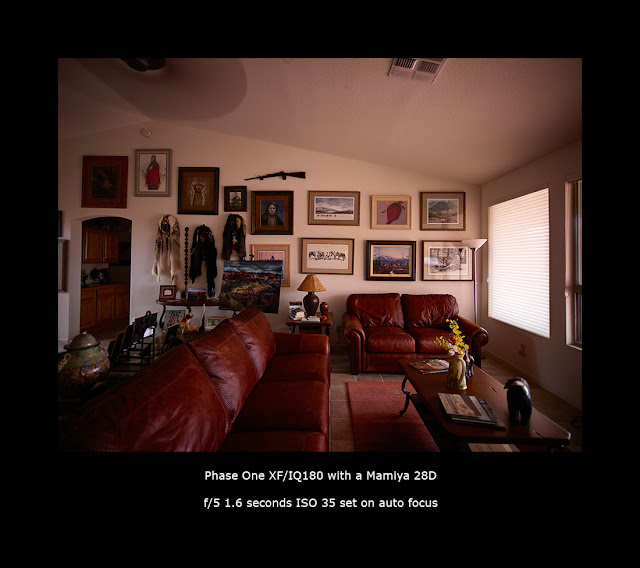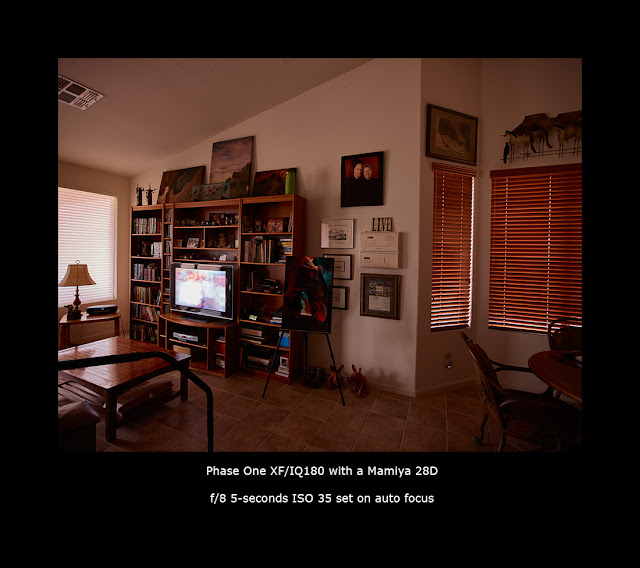One of the first images I took shortly after getting the
Mamiya 28mm D lens. Top sample is full frame 80-megapixels; the bottom is
cropped to 60.
I used to own a Mamiya 28mm lens years ago using it
successfully on a Phase One P30+ and P45+ digital backs. The P30+ was 31.6 megapixels with a crop
factor of 1.25 while the P45+ was 39-megapixels and a crop of 1.15 and when it was
introduced was said to be “near” full frame medium format. A full frame medium
format digital back sensor size is 53.9x40.4mm (Phase One P65+, IQ160, IQ180 as
well as the newer IQ260 and 360 and 280 and 380 are all “full frame” digital
backs) Bear with me as I’m about to make a point.
Full frame no cropping
The P30+ has a sensor size of 44.2x33.1 while the P45+ a
sensor size of 49.1x36.8mm. These two
backs were ideal for a 28mm lens due to the cropping. However once full frame backs were released
the lens no longer was ideal since there wasn’t any cropping and we shortly
found the corners of the images were soft. I stopped using a 28mm lens shortly
after I traded the P30+ for a P45+ mainly due to the fact I had begun using a
technical camera.
Full frame no cropping
The other aspect was just how well software processing
was at the time. Capture One Pro (C1) is
currently as of this writing at v8 while I’m uncertain the time frame I believe
C1 was around 4 in 2005. A lot of improvements have been made especially for wide angle lenses.
Full frame sample, handheld f/9 1/800 ISO 35
I’ve recently begun using my new Phase One XF much more
than my Cambo WRS and have also revamped my lenses switching to the new leaf
shutter system and the 40-80LS, 75-150LS and the 240LS lineup. With this I also began to wonder about going
wider than the 40 or the new 35mm LS lens and began to look at the 28mm again.
In researching the 28mm (both the older D model and newer LS) I was told that the 28 wouldn’t work well with an 80-megapixel back. Soft corners and color problems were just some of the concerns mentioned. I had to see for myself.
Shot directly into the sun, f/11 1/640 ISO 35 (full frame)
I found a Mamiya 28mm D lens at a price that was hard to
pass up. I figured I’d try it to see for myself. My biggest concerns was color cast, figuring
that I could work around soft corners. I
began thinking that the 28mm would make a good 30-32mm lens which was what I
was after.
I’ve had the Mamiya 28mm now for a little over a week and
have seen no problems with color cast. Let me make that very clear. I’ve had
zero color cast problems. I’ve tested
this lens indoors as well as outside in soft light as well as hard afternoon
light. So in the end my biggest concern never appeared. Have I mentioned I have had no color cast
issued?
So there you have it. The 28mm does work well with an 80-megapixel digital back due in large part to the improvements of the software of Capture One Pro.
Handheld, f/9 1/320 ISO 100 (full frame)
Handheld, f/11 1/200 ISO 100 (full frame)
As stated earlier I’ve been using this with my new Phase
One XF body and an 80-megapixel IQ180.
So far the majority of the outside testing has been handheld with the
indoor samples on tripod. This is what I’ve seen so far…
The center is sharp; but then I’d expect that. The top
corners are sharper than what I thought they’d be while the bottom corner tend
to be soft or mushy. The bottom may be
due to the height and angle I’ve captured the images. They also might be due to the fact that the
majority of captures are with auto focus.
I’ve been using aperture settings of f/8 to f/11 and it appears that f/9
and f/11 work the best. I’ve also seen
that I can generally crop the image and achieve a very pleasing image that is
generally in the 60-megapixel range after cropping.
Full frame no cropping
The sore spot when I first used the 28mm was a lack of
filters as the lens shade is a permanent fixture. Thankfully that’s been fixed by Lee filters
with their introduction of the SW150; and to be honest I wouldn’t have thought
about the 28 if I couldn’t use filters.
I have the SW150 on order and will add my thoughts after I’ve used it
for a while.
This is my first 2-shot handheld then stacked for focus
test image. f/11 1/125 ISO 35 (full frame)
2-shot on tripod then stacked for focus. f/11 1/250 ISO
35 (full frame)
So there you have it. The 28mm does work well with an 80-megapixel digital back due in large part to the improvements of the software of Capture One Pro.
As always let me know if you have questions or comments.
Don














No comments:
Post a Comment